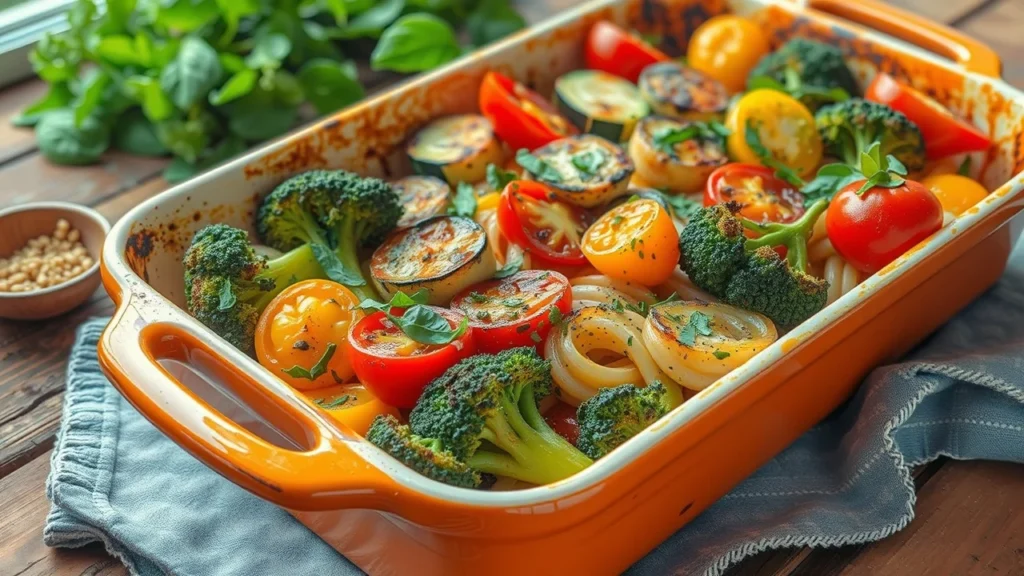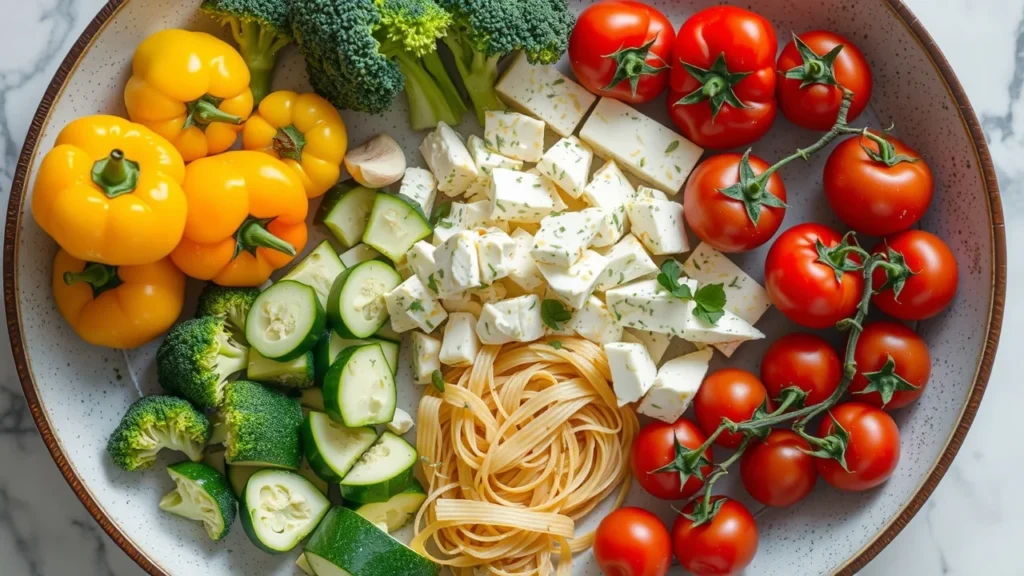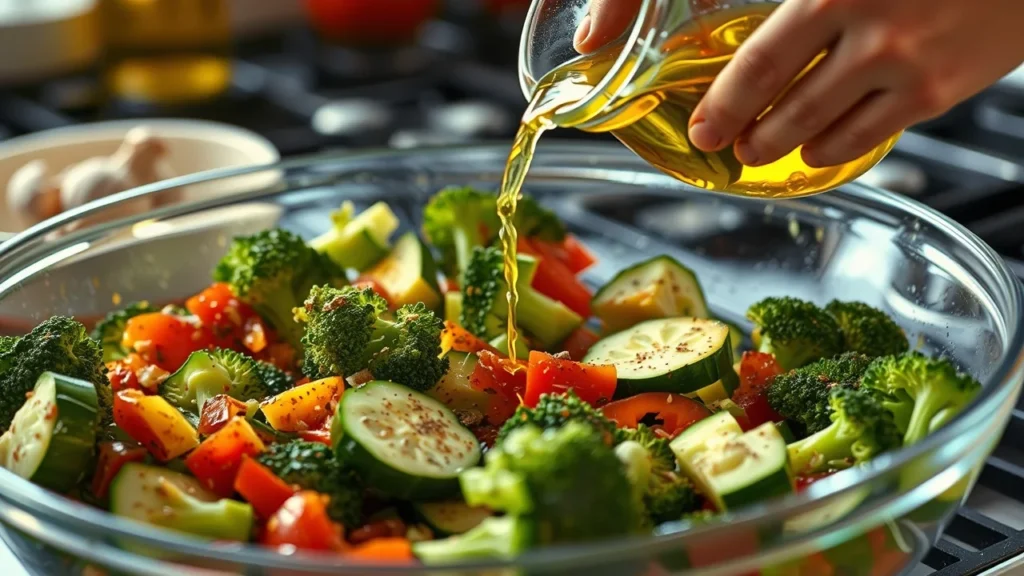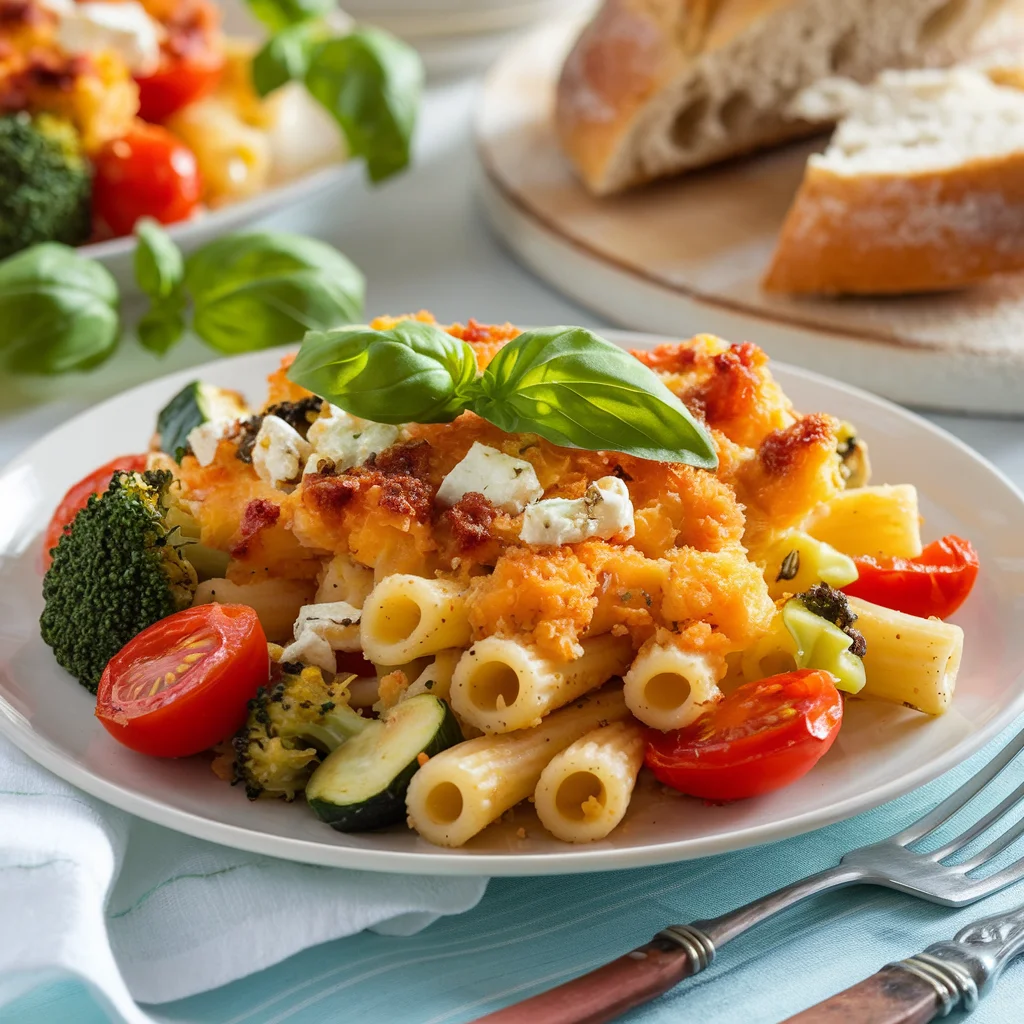Baked feta cheese pasta with vegetables is the perfect blend of creamy, tangy feta and the natural sweetness of roasted veggies. feta cheese pasta has taken the culinary world by storm, thanks to its creamy texture, rich flavor, and simplicity. Originating as a viral sensation, this dish quickly became a household favorite for its ease of preparation and delicious results. But while the original recipe is satisfying, adding more vegetables elevates the dish to a new level of healthfulness and flavor complexity. This guide will show you how to prepare a vibrant, veggie-packed version of baked feta cheese pasta that’s as nutritious as it is delicious.
Introduction

Baked feta cheese pasta is a simple yet indulgent dish that became a global phenomenon after gaining attention on social media platforms like TikTok and Instagram. Its charm lies in its minimal ingredient list and straightforward preparation. At its core, the recipe involves baking a block of feta cheese alongside cherry tomatoes, garlic, olive oil, and seasonings. Once baked, the creamy, tangy feta and burstingly sweet tomatoes are combined with cooked pasta to create a rich, flavorful sauce.
How to Make Baked Feta Cheese Pasta with Vegetables?
The recipe originated in Finland and gained international fame after food bloggers and influencers showcased its versatility and ease. While the traditional version is undeniably delicious, there’s room to enhance its nutritional profile by incorporating an array of colorful vegetables. This twist not only improves the dish’s health benefits but also adds texture, vibrancy, and more complex flavors.
Why Add More Vegetables?
While baked feta pasta is already a crowd-pleaser, adding more vegetables transforms it into a balanced, nutrient-packed meal. Here are some compelling reasons to include extra veggies:
Nutritional Benefits
Vegetables are rich in essential vitamins, minerals, and antioxidants. By adding greens like spinach, cruciferous vegetables like broccoli, or bell peppers, you boost the fiber content, aiding digestion and promoting overall health. This adaptation makes the dish more than just a comfort food – it becomes a nutritious, well-rounded meal.
Enhanced Flavor Profiles
The creamy, salty feta pairs beautifully with the natural sweetness of roasted vegetables. When you introduce earthy zucchini, vibrant bell peppers, or slightly bitter kale, the dish gains a delightful complexity. Each vegetable contributes its unique taste, making every bite exciting and satisfying.

Texture and Variety
Vegetables add a pleasing variety of textures to the dish. Roasted zucchini brings tenderness, broccoli adds a slight crunch, and spinach creates a silky mouthfeel. This combination ensures that the pasta isn’t monotonous but instead a medley of flavors and sensations.
Best Vegetables to Include
Classic Cherry Tomatoes
Although cherry tomatoes are already a staple in the traditional recipe, you can elevate their presence by adding even more. Their natural sweetness deepens when roasted, creating the perfect balance with feta’s tanginess.
Zucchini
Zucchini is a fantastic addition because of its mild flavor and soft texture. When roasted, it becomes slightly caramelized, adding a subtle sweetness to the dish.
Broccoli
Broccoli adds a hearty crunch and a touch of bitterness that contrasts well with the creamy feta. Its florets soak up the sauce beautifully, making each bite extra flavorful.
Spinach or Kale
Adding leafy greens like spinach or kale provides a fresh, earthy note. They also wilt quickly in the heat of the baked dish, blending seamlessly into the sauce.
Bell Peppers
For a burst of color and sweetness, bell peppers are a fantastic choice. Red, yellow, or orange peppers add vibrant hues and enhance the dish’s overall visual appeal.
Mushrooms
Mushrooms bring an umami depth to the recipe. They absorb the olive oil and seasoning while roasting, contributing a rich, meaty flavor that complements the feta.
Step-by-Step Guide to Preparing Baked Feta Cheese Pasta with Vegetables
Adding more vegetables to baked feta pasta is simple and rewarding. With just a few adjustments to the original recipe, you can transform it into a more wholesome and flavorful dish. Below is a detailed, step-by-step guide to preparing baked feta cheese pasta with an abundance of vegetables.
Gather Ingredients
To make this dish, you’ll need the following ingredients:
Main Ingredients:
- 1 block of feta cheese (about 200g)
- 3 cups of cherry tomatoes
- 1 medium zucchini, sliced
- 1 cup broccoli florets
- 1 red bell pepper, chopped
- 2 cups spinach or kale leaves
- 4 garlic cloves, minced
- 2 tablespoons olive oil
- 300g pasta of your choice (penne, fusilli, or farfalle work best)
- Salt and pepper to taste
Optional Ingredients for Customization:
- Mushrooms, sliced (½ cup)
- Crushed red pepper flakes for heat
- Fresh herbs like basil or parsley for garnish
- Lemon zest for added brightness
Prepping the Vegetables
Properly preparing the vegetables is key to achieving a flavorful and balanced dish.

- Wash and Chop: Start by thoroughly washing all the vegetables to remove any dirt or pesticides. Slice the zucchini into rounds, chop the bell pepper into small cubes, and cut the broccoli into bite-sized florets. If you’re using spinach or kale, rinse the leaves and pat them dry.
- Season Generously: In a large mixing bowl, combine the chopped vegetables with olive oil, garlic, salt, and pepper. Toss well to ensure every piece is evenly coated. This step is essential for roasting the vegetables to perfection.
- Layer Strategically: Arrange the seasoned vegetables around the feta block in your baking dish. Placing them in a single layer ensures even cooking and prevents overcrowding, which could lead to steaming instead of roasting.
Baking the Feta and Vegetables
Baking is where the magic happens. Here’s how to get it just right:
- Preheat the Oven: Preheat your oven to 400°F (200°C) to ensure even baking.
- Assemble the Dish: Place the feta block in the center of a large baking dish. Surround it with the seasoned vegetables and cherry tomatoes. Drizzle a little extra olive oil over the feta and sprinkle with crushed red pepper flakes if desired.
- Bake to Perfection: Bake for 25–30 minutes, or until the tomatoes burst, the vegetables caramelize, and the feta becomes soft and creamy. The roasted vegetables will develop a slight char, adding depth to the flavor.
Step 4: Mixing Pasta and Sauce
Once the baking is done, it’s time to bring everything together:
- Cook the Pasta: While the vegetables and feta bake, bring a pot of salted water to a boil and cook your pasta until al dente. Reserve ½ cup of the pasta water before draining.
- Create the Sauce: Remove the baking dish from the oven and use a fork to mash the softened feta and roasted vegetables. Mix them together to create a creamy, chunky sauce. Add a splash of the reserved pasta water to loosen the mixture if needed.
- Combine: Toss the cooked pasta into the baking dish and mix thoroughly until every piece is coated in the sauce. Add the spinach or kale at this stage; the residual heat will wilt the greens beautifully.
- Taste and Adjust: Taste the pasta and adjust the seasoning with more salt, pepper, or a squeeze of fresh lemon juice for brightness.
Tips for the Perfect Dis
Even a simple recipe can be improved with the right techniques. Here are some expert tips for perfecting your roasted vegetable feta pasta:
Choosing the Right Feta Cheese
Opt for a high-quality, creamy feta cheese made from sheep’s or goat’s milk. Avoid pre-crumbled feta, as it lacks the same creaminess and flavor.
Using Fresh Vegetables
Fresh, in-season vegetables will yield the best results. They roast beautifully and retain their vibrant flavors.
Don’t Skip Roasting
Roasting enhances the natural sweetness of the vegetables and intensifies their flavors. Be patient and allow the vegetables to caramelize for the best taste.
Experiment with Seasoning
While the basic recipe uses garlic, salt, and pepper, feel free to add other spices like paprika, oregano, or thyme to suit your taste.
Customizing the Recipe
One of the best things about roasted vegetable feta pasta is its flexibility. You can tweak the recipe to suit dietary preferences, personal tastes, or the ingredients you have on hand. Here are a few ways to customize the dish:
Gluten-Free and Vegan Options
Gluten-Free Pasta
If you’re gluten-intolerant or simply avoiding gluten, swap out regular pasta for gluten-free options like chickpea, lentil, or rice-based pasta. These alternatives are not only gluten-free but also packed with protein and fiber.
Vegan Alternatives
To make this dish vegan, replace the feta cheese with a plant-based alternative. Vegan feta, made from ingredients like tofu or almonds, mimics the creaminess and tanginess of traditional feta. You can also add nutritional yeast to enhance the cheesy flavor.
Trying Different Pasta Shapes
While the recipe traditionally uses short pasta like penne or fusilli, you can experiment with other shapes.
- Long Pasta: Spaghetti or linguine creates a different eating experience, twirling the sauce around each bite.
- Unique Shapes: Fun pasta shapes like cavatappi or campanelle can hold the creamy sauce and roasted veggies well.
Alternative Cheeses
If feta isn’t your favorite, there are plenty of other cheeses you can use:
- Goat Cheese: A milder, tangy option that melts beautifully.
- Ricotta: For a lighter, creamier texture.
- Mozzarella or Burrata: For a gooey, stretchy twist.
Protein Additions
For a more filling dish, consider adding protein:
- Chicken or Shrimp: Cooked chicken pieces or sautéed shrimp can be mixed into the pasta after baking.
- Chickpeas or Lentils: Vegetarian protein options that pair well with the creamy sauce and roasted veggies.
Pairing Suggestions
A dish as rich and flavorful aspairs beautifully with complementary sides and drinks. Here are some ideas to complete your meal:
Sides to Serve
Garlic Bread
A warm, crispy slice of garlic bread is perfect for scooping up every bit of the creamy sauce.
Mixed Green Salad
A simple salad with fresh greens, cucumbers, and a tangy vinaigrette provides a refreshing contrast to the pasta’s richness.
Roasted Vegetables
If you can’t get enough of roasted veggies, serve a side of additional vegetables like asparagus, carrots, or Brussels sprouts.
Drinks to Pair
White Wine
A crisp white wine, like Sauvignon Blanc or Pinot Grigio, cuts through the richness of the feta and complements the freshness of the vegetables.
Lemon-Infused Water
For a non-alcoholic option, lemon-infused water or sparkling water with a hint of lime enhances the dish’s bright flavors.
Light Beer
If you prefer beer, a light lager or wheat beer pairs well with the tangy feta and roasted vegetables.
Storage and Reheating
If you have leftovers, don’t worry! This dish stores well and can be reheated for later enjoyment.
How to Store Leftovers
- Cool Completely: Let the pasta cool to room temperature before storing to avoid condensation.
- Use an Airtight Container: Transfer the pasta to an airtight container and refrigerate. It will stay fresh for up to 3–4 days.
Reheating Techniques
On the Stovetop
Heat a small amount of olive oil in a pan, then add the pasta and cook over medium heat. Add a splash of water or milk to loosen the sauce as it heats.
In the Microwave
Place a portion in a microwave-safe dish, cover with a lid or damp paper towel, and heat for 1–2 minutes. Stir halfway to ensure even heating.
In the Oven
Reheat the entire dish in a preheated oven at 350°F (175°C) for about 10–15 minutes. Cover the baking dish with foil to prevent it from drying out.
Common Mistakes to Avoid
Even with its simplicity, there are a few pitfalls to avoid when preparing baked feta cheese pasta with vegetables:
Overbaking the Feta
Baking the feta for too long can make it dry and crumbly rather than creamy. Stick to the recommended baking time of 25–30 minutes.
Skipping the Roasting Step
Roasting the vegetables and tomatoes is essential for bringing out their sweetness and flavor. Don’t rush this step by underbaking.
Not Seasoning Properly
Vegetables and pasta need proper seasoning to shine. Don’t forget to add salt and pepper at every stage of preparation.
Using Low-Quality Feta
Pre-crumbled feta or low-quality cheese will result in a less creamy and flavorful dish. Choose a block of high-quality feta for the best results.
FAQs
Can I use other cheeses besides feta?
Yes! While feta is traditional, alternatives like goat cheese, ricotta, or even vegan cheese can work well. Each brings its unique flavor and texture.
Can I make this dish gluten-free?
Absolutely. Swap out regular pasta for gluten-free varieties like rice-based, chickpea, or quinoa pasta.
How can I make this dish vegan?
Replace feta cheese with a plant-based alternative, such as almond-based feta or tofu-based cheese. Add nutritional yeast for an extra cheesy flavor.
Can I prepare this dish in advance?
While it’s best fresh, you can prepare the sauce in advance and store it in the fridge for up to 2 days. Reheat and mix with freshly cooked pasta when ready to serve.
What’s the best pasta shape for this recipe?
Short pasta like penne, fusilli, or rigatoni works best because it holds the sauce well. However, you can experiment with any shape you prefer.

How can I make the dish spicier?
Add crushed red pepper flakes, chili oil, or diced fresh chili peppers to the baking dish for an extra kick.
Conclusion
Baked feta cheese pasta with more vegetables is the ultimate combination of comfort and nutrition. By adding a variety of fresh, roasted vegetables, you can create a dish that’s not only delicious but also vibrant and healthy. Whether you stick to the traditional ingredients or customize the recipe to suit your taste, this pasta dish is sure to become a favorite in your home. So grab your baking dish, pick your favorite veggies, and enjoy a wholesome twist on this viral sensation.

